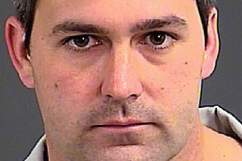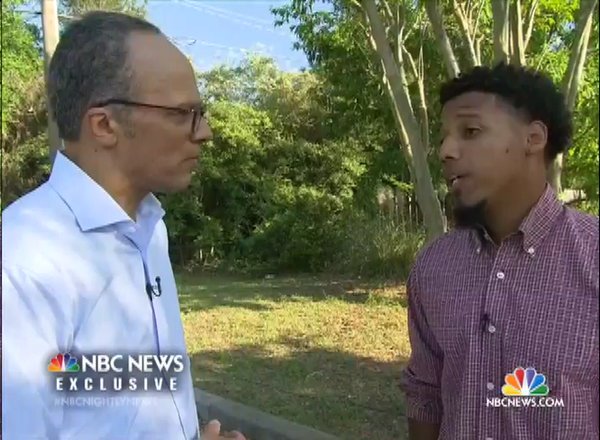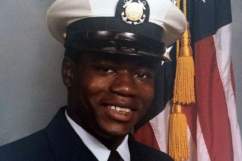
Feidin Santana, right, is interviewed by NBC Nightly News anchor Lester Holt. (Lester Holt/Twitter)
The South Carolina man who filmed the fatal shooting of Walter Scott by a North Charleston police officer has come forward in an interview with NBC News.
Feidin Santana’s recording led authorities to charge officer Michael Slager with murder in Scott’s death, as it showed Slager firing eight times at Scott’s back as Scott ran away from the officer. Scott was shot five times and died at the scene. Slager claimed he killed Scott in self defense after Scott took his Taser, but the video contradicted that claim.
Here’s what you need to know:
1. Santana Started Recording After Hearing Slager’s Taser
(Warning: Graphic Video)
Santana said he was walking to his job at a barber shop when he saw Scott being chased by police. He said he was on the phone and he decided to go over there and see what was going on. He started recording when he heard a Taser being deployed.
Santana told NBC Nightly News anchor Lester Holt:
They were down on the floor before I started recording. I remember the police had control of the situation. He had control of Scott. And Scott was trying just to get away from the Taser.
The video begins with Slager and Scott in close range. An object falls to the ground and Scott can be seen running away from Slager with the strings from the Taser prongs hanging from his body. As he gets a few feet away from Slager, Scott opens fire, shooting seven times as Scott runs farther away. He then pauses and fires an eighth time. Scott then drops to the ground. Scott’s family said he was shot five times.
“As you can see in the video, the police officer just shot him in the back,” Santana told NBC News. “I knew right away, I had something on my hands.”
He said he heard no warnings from the officer before he fired. None can be heard in the video.
Santana said the officer “made a bad decision,” and “you pay for your decisions in this life.”
2. He Gave the Video to Scott’s Family
Santana, who is originally from the Dominican Republic, said he gave the video to the Scott family. They then turned it over to police. It was later sent to the Charleston Post and Courier and the New York Times.
“They were very emotional when that happened, including me also,” he told NBC News. “I thought about his position, their situation … If I were to have a family member that would happen [to], I would like to know the truth.”
Santana told Scott’s family he didn’t release the video immediately because he wanted to see how police handled the case.
“He wanted to see what reports were coming from the North Charleston Police Department because of the fact that they may have told the truth,” Scott’s brother told TIME on Wednesday. “And when they continued with the lies, he said, ‘I have to come forward.'”
Santana told the Associated Press, “I felt that my life, with this information, might be in danger.”
3. He Has Been Called a Hero By Scott’s Family
The Scott family’s attorney and others have praised Santana as a hero. Attorney Chris Stewart said at a press conference Tuesday night, ““We have to really recognize the strength and fortitude and fearlessness that it took to come forward when you know you just filmed a police officer murder somebody.”
He told NBC News:
It’s not something that no one can feel happy about. He has his family, Mr. Scott also has his family. But I think, you know, he [the officer] made a bad decision, and you pay for your decisions in this life. Mr. Scott didn’t deserve this, and there were other ways that can be used to get him arrested, and that wasn’t the proper way to do that.
4. The Video Was a Turning Point in the Investigation
In statements made before the video was released, Slager claimed he feared for his life after Scott took his Taser from him.
Police said Scott’s Mercedes-Benz sedan was stopped because it had a broken brake light, according to the newspaper. Scott ran away from Slager, who chased him. During the chase, Scott confronted Slager, his attorney said in a statement. Slager took out his Taser, but he said Scott took the device during the struggle, overpowering the officer and making him fear for his life.
Slager said he then fired at Scott because he “felt threatened,” Slager’s attorney said Monday in a statement.
“This is a very tragic event for all of the families,” his attorney, David Aylor, said in the statement. “I believe once the community hears all the facts of this shooting, they’ll have a better understanding of the circumstances surrounding this investigation.”
Aylor is no longer Slager’s attorney, saying in a post on his website Tuesday, “Today, I withdrew my representation of Michael Slager. This is a terrible tragedy that has impacted our community.”
The officer can be heard on police radio recordings saying, “Shots fired and the subject is down. He took my Taser.”
Listen to the dispatch audio here (the incident begins at about the 7:30 mark of the recording with the traffic stop):
The incident begins in the audio at about the 7:30 mark of the 30-minute recording as Slager calls in a traffic stop. He was pulling over Scott’s Mercedes-Benz for a broken light, police said.
Slager can be heard at about the 10:35 mark of the recording calling dispatch to announce he’s in a foot chase, describing the suspect as black in a green shirt and blue pants. The dispatcher then repeats his description and calls for radio silence other than transmissions related to the chase.
At about 11:05 of the recording, another officer says he’s in route to join the chase. Slager then tells the other officers of his new location and can be overheard telling someone to “get down on the ground.”
At 12:27 (9:38 a.m.), as the other officers try to find Slager, he says, “shots fired. Subject is down. He grabbed my Taser.”
Slager then says a minute later that he needs his vehicle secured. He says the suspect has gun shot wounds to the chest, thigh and buttocks and is unresponsive. He tells the dispatcher the scene, behind a pawn shop in a field, is secure.
Another officer then arrives and confirms the injuries to the victim. He then begins to provide first aid, including chest compressions. An EMS unit arrives at the scene at about the 19:43 mark of the tape, about six minutes after Slager called in the shooting.
5. North Charleston Police Will Be Getting Body Cameras

North Charleston Mayor R. Keith Summey (L) and Police Chief Eddie Driggers take questions during a press conference at City Hall in Charleston, South Carolina on April 8, 2015. The white police officer who fatally shot a fleeing black man in the US city of North Charleston has been fired after he was charged with murder, the mayor said. (Getty)
The Scott family’s attorney, lawmakers and others have said that if it wasn’t for the video, the police officer’s version of events likely would have been trusted and charges would not have been filed against him. North Charleston officials said they hope to combat that notion by acquiring body cameras for their officers.
L. Chris Stewart, the Scott family’s attorney, said anyone who watches the video can clearly see it was murder. He said he is “disappointed that the initial reports were totally on the side of the officer. The spokesperson for the police reported that ‘the man tried to grab the Taser’ and once again if we’d just took the initial newspaper reports, it would have been ‘why’d that guy grab the Taser, he shouldn’t have tried to hurt a cop.’ But that wasn’t what happened. And the truth came out.”
Mayor Keith Summey said at a press conference a day after Slager’s arrest that the city has ordered 250 body cameras. Every officer on the street will wear one once a policy is established and training is completed.
Watch full video of Wednesday’s press conference below:


